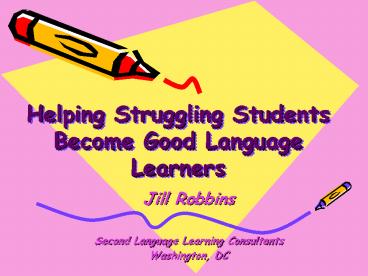Helping Struggling Students Become Good Language Learners PowerPoint PPT Presentation
1 / 35
Title: Helping Struggling Students Become Good Language Learners
1
Helping Struggling StudentsBecome Good Language
Learners
- Jill Robbins
- Second Language Learning Consultants
- Washington, DC
2
Who is the Struggling Student?
- This student has problems with
- keeping up with classmates
- organizing him/herself and the work environment
- following verbal instructions
- longer-term work tasks (work that has not been
chunked into manageable pieces) - social and emotional skills
3
How do we help the struggling student?
- Support the learning process with strategies
instruction scaffolding - Teach academic language
- Provide English Language Learners a doorway to
mainstream content - Find out students interests and build from them
4
Research Support for Teaching Learning Strategies
- All second language learners use strategies - BUT
- Good language learners use more varied
strategies and use them more flexibly. - Frequent use of learning strategies is correlated
to higher self-efficacy.
5
More Research Findings
- Strategy instruction improves academic
performance. - Instruction needs to be explicit.
- Students need to develop metacognition.
- Transfer is difficult.
- Language of instruction matters.
6
THE COGNITIVE ACADEMIC LANGUAGE LEARNING APPROACH
(CALLA)
7
PURPOSE OF CALLA
- Focus on learner.
- Improve academic language proficiency.
- Motivate with content topics.
- Teach learning strategies for more effective
learning.
8
AUTHENTIC CONTENT
- Aligned to curriculum standards.
- Interesting school and cultural topics.
- Linked to students prior experiential and
cultural knowledge. - Taught through hands-on/inquiry-based/cooperative
learning tasks.
9
ACADEMIC LANGUAGE
- Language development through content across all
curriculum areas. - Vocabulary and discourse of content subjects and
cultural topics. - Linked to students prior linguistic knowledge.
- Development of language awareness.
10
LEARNING STRATEGIES
- Thoughts and actions that assist learning tasks.
- Ways to understand, remember, and recall
information. - Ways to practice skills efficiently.
11
CALLA Sites
Lowell, MA McAllen, TX Mesa, AZ New York, NY
Ogden, UT Philadelphia, PA Washington, DC
Alief, TX Allentown, PA Arlington, VA Bethel,
AK Boston, MA
Fargo, ND Federal Way, WA Houston, TX
Chula Vista, CA Dearborn, MI El Paso, TX
12
CALLA INSTRUCTIONAL SEQUENCE
- Five Recursive Phases
13
Preparation
Expansion
CALLAs Five Phases
Self- Evaluation
Presentation
Practice
14
PREPARATION
- Identify objectives.
- Elicit students prior knowledge.
- Develop vocabulary.
- Provide motivation.
15
PREPARATION
- How does preparation help struggling students?
- What works to encourage vocabulary development?
- How can teachers stimulate increased motivation
in struggling students?
16
PRESENTATION
- Present new information in varied ways.
- Model processes explicitly.
- Explain learning strategies.
- Discuss connections to students prior knowledge.
17
PRESENTATION
- What kinds of presentation methods would help the
struggling learner? - Does presenting with a variety of media help
struggling students?
18
PRACTICE
- Use hands-on/inquiry-based activities.
- Provide different cooperative learning
structures. - Use authentic content tasks.
- Ask students to use learning strategies.
19
PRACTICE
- What kinds of practice activities would help the
struggling learner? - Which are better for struggling students,
individual or cooperative group practice
activities?
20
SELF-EVALUATION
- Students reflect on their own learning.
- Students evaluate themselves.
- Students assess their own strategy use.
21
SELF-EVALUATION
- What are the benefits of SELF-evaluation vs.
evaluation by others? - How can you help struggling learners to evaluate
themselves more accurately?
22
EXPANSION
- Students apply information to own lives.
- Students make connections between language and
content. - Students relate information to first language
knowledge. - Parents contribute to learning.
23
EXPANSION
- How can what has been learned in ESOL class help
struggling learners in their other classes? - Can better communication with parents or
involvement of the community help struggling
students?
24
CALLA Instruction Summary
Teacher Responsibility
Changes over time
Prepare Present
Practice Self-Evaluate Expand
Student Responsibility
25
Research Findings
- The learning process is mentally active and
strategic. - Learning involves higher level thinking, not just
memory. - Social context and interaction are critical.
- Students learn content by relating it to their
prior knowledge. - Students learn processes through integrative
practice individually and with peers. - Learning strategies can be taught and learned.
26
THINKING ABOUT THINKING A MODEL OF METACOGNITION
- Declarative Knowledge
- Self Knowledge
- World Knowledge
- Task Knowledge
- Strategy Knowledge
- Procedural Knowledge
- Planning
- Monitoring/ Identifying Problems
- Evaluating
27
Why Teach Learning Strategies?
- Show students how to be better learners.
- Build students self-efficacy.
- Increase student motivation for learning
- Help students become reflective and critical
thinkers.
28
TIPS ON TEACHING LEARNING STRATEGIES
- Build on students current learning strategies.
- Demonstrate how to use the learning strategy by
modeling. - Give the strategy a name.
- Provide ample practice opportunities.
29
Metacognitive Strategies
- Planning
- Understand the task
- Organize materials
- Find resources
30
Metacognitive Strategies
- Monitoring While working on a task
- Check your progress on the task.
- Check your comprehension as you use the language.
Do you understand? If not, what is the problem? - Check your production as you use the language.
Are you making sense? If not, what is the
problem?
31
Social Learning Strategies
- Cooperation work with others to
- complete tasks
- build confidence
- give and receive feedback
32
Metacognitive Strategies
- Evaluation after completing a task
- Assess how well you have accomplished the
learning task. - Assess how well you have used learning
strategies.
- Decide how effective the strategies were.
- Identify changes you will make the next time you
have a similar task to do.
33
Metacognitive Strategies
- Self-Management Manage Your Own Learning
- Determine how you learn best.
- Arrange conditions that help you learn.
- Seek opportunities for practice.
- Focus your attention on the task.
34
CALLA Instruction Is...
- Learner-centered
- Reflective
- Supportive
- Focused
- Enthusiastic
35
Thanks for listening!

